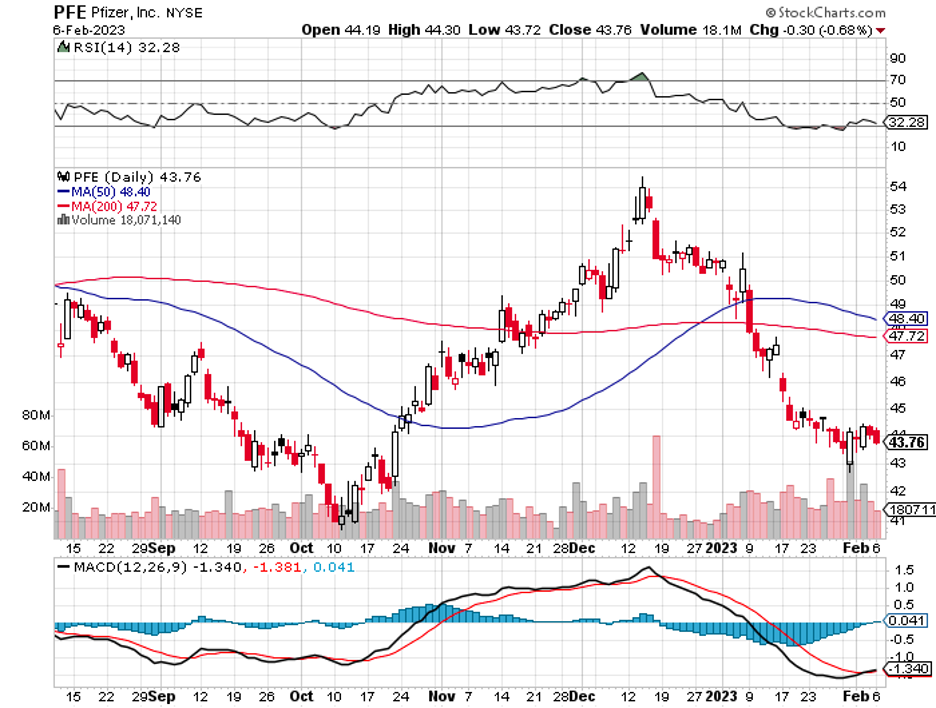Pfizer (PFE) possibly contributed more than any other business in getting the world back to normal from the pandemic. It was rewarded with an impressive windfall courtesy of its twin COVID-19 programs: the blockbuster vaccine and the top-selling treatment, Paxlovid.
However, the world has already stopped fretting over COVID. As expected, Pfizer is paying the price for this turn of events. Sales of its COVID blockbusters are estimated to decline by more than 60% in 2023 after raking in a total of roughly $57 billion in 2022.
The company projects that Comirnaty vaccine sales would fall from $37.8 billion in 2022 to $13.5 billion in 2023, while Paxlovid would drop from $18.9 billion to $8 billion. After all, the United States and several countries already have massive stockpiles of the Pfizer vaccine and Paxlovid, recorded under the 2022 revenue. It would take until June 2023 to work through them.
In effect, Pfizer and other COVID plays like Moderna (MRNA), Novavax (NVAX), and BioNTech (BNTX) have fallen out of favor.
Still, Pfizer remains positive about the future of its COVID franchise. The company anticipates that 24% of Americans, or about 79 million, will get a COVID vaccine in 2023. In comparison, 31% or roughly 104 million, received the vaccine in 2022. Pfizer also expects to sustain its dominance, with a 64% market share for the vaccine alone.
Moreover, Pfizer has a robust pipeline—and pipelines are the driving force behind drug stocks.
With mRNA technology's momentum, Pfizer is optimistic about its combined flu-COVID vaccine. The company foresees around 132 million Americans lining up for this two-disease vaccine, which it hopes to launch by 2026.
Shifting the discussion away from COVID, Pfizer estimates non-COVID revenue to increase by 6% annually through 2025, then projects a similar trajectory or better every year through 2030 to hit at least $70 billion.
Announcing these projections is a bold move, especially since Pfizer faces one of the most significant patent cliffs starting 2025 to 2028. Several top-selling treatments, which generate roughly $17 billion in yearly sales, will lose patent protection and face generic competition.
Pfizer is aggressively filling these anticipated voids with acquisitions, including three exciting companies: Global Blood Therapies, Biohaven Pharmaceuticals, and Arena Pharmaceuticals.
In 2022 alone, the company spent $26 billion, which granted Pfizer access to promising drugs for sickle-cell anemia, migraines, and ulcerative colitis.
By 2030, the company projects these and its subsequent acquisitions to generate at least $25 billion in annual revenue. This means it’s still on the lookout for more acquisitions.
Actually, the company estimates that it’s just 40% on the way to hitting its target of $25 billion in 2030 revenue coming from acquired treatments. This means the company would most likely spend another $50 billion in acquisitions to reach its goal.
In terms of its internal pipeline, Pfizer’s candidates can rake in at least $20 billion in sales by 2030. Some of its key launches include vaccines for the flu, meningitis, and respiratory syncytial virus (RSV). It also has treatments targeting blood cancer and atopic dermatitis.
Meanwhile, its oral diabetes and obesity products, which are currently in clinical trials, have the potential to generate roughly $10 billion in annual sales. If approved, these would allow Pfizer to go head-to-head against Eli Lilly (LLY) and Novo Nordisk (NVO).
Overall, Pfizer is an “iconic, blue-chip company” that’s on a discount these days. It is down roughly 15% this 2023, offering an excellent window for investors who want to buy the stock.
The company trades for 13 times its estimated earnings in 2023 and yields 3.7%, which is over double the S&P’s dividend rate. With this payout, along with its solid earnings and one of the best balance sheets across the industry, Pfizer looks incredibly safe.
However, it’s essential to be realistic. Pfizer’s goal is to go through this year minimally unscathed. Although its performance in 2022 was impressively strong, with revenue surging to a whopping $100 billion compared to $42 billion in 2020, the year 2023 is a reset period for the business.


